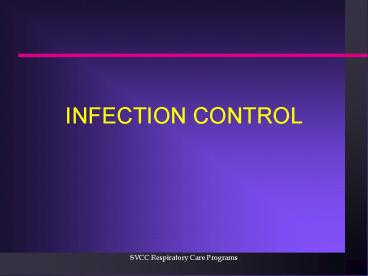INFECTION CONTROL - PowerPoint PPT Presentation
1 / 13
Title: INFECTION CONTROL
1
INFECTION CONTROL
2
Introduction
- An infection is an invasion of the body by
pathogenic microorganisms - Disease results if the pathogens multiply and
cause an alteration in normal tissue function - Pathogenic organisms include bacteria, viruses,
fungi, protozoa, and rickettsiae - All organisms require food and the proper
environment for growth
3
Chain of Infection
- Development of an infection occurs in a cycle
that depends on 6 elements - 1. infectious agent or pathogen
- 2. reservoir or source for pathogen growth
- 3. portal of exit from the reservoir
- 4. mode of transmission
- 5. portal of entry to host
- 6. susceptible host
4
Modes of Transmission
- Contact - Direct (between infected or
colonized person and susceptible host) - - Indirect (by contam. inanimate object -
Droplet contact (travel up to 3 ft., not
airborne) - Air
- - droplet nuclei (residue of evaporated
droplets remain suspended)
5
Modes of Transmission (contd)
- Air (contd) - dust (contains infectious
agents - Vehicle - contaminated items, i.e.,
liquids (water, drugs, blood) or food - Vectors - insects, i.e., mosquito, fleas,
ticks, lice - animals, i.e., cows, pigs
6
Transmission (contd)
- Most microbial diseases are spread by the four
Fs - fingers - flies -
fomites - food
7
Risk Factors for Infection
- Inadequate primary defenses
- - broken skin or mucosa - traumatized
tissue - decreased ciliary action -
obstructed urine outflow - altered
peritalsis - Inadequate secondary defenses - reduced
hemoglobin - suppression of lymphocytes -
low WBC count, suppress. immun.
8
Nosocomial Infections
- Results from delivery of health services in a
health care facility - May be exogenous - from microbes external to
pt. which are not part of normal flora - May be endogenous - can occur when pt.s
flora becomes altered, i.e., entercocci, yeast,
streptococci
9
Nosocomial (contd)
- To minimize the onset and spread of infection
efforts must be directed toward aseptic
techniques - Medical asepsis (clean technique) - procedures
used to reduce the of microbes and prevent
spread, i.e., handwashing, changing linen daily - Surgical asepsis (sterile technique)
- - eliminated microbes from an area, i.e.,
O.R., suctioning, dressing changes
10
Controlling Infection
- Preventing the onset and spread of infection and
promoting measures for treatment of infection - Prevent by - eliminating reservoirs of
infection - avoiding actions that transmit
microbes - disinfection and sterilization of
supplies - strengthen hosts defenses, i.e.,
nutrition
11
Controlling Infect. (contd)
- Treatment of infection - eliminating the
organisms - supporting pts defenses, i.e,
bronchial hygiene
12
Sputum Color
- Normally white and translucent
- Yellow indicates pus, since WBCs have a yellow
color - Green indicates old, retained secretions,
proteolysis of mucopolysaccharides - - if green and foul odor, usually a
Pseudomonas infection - Brown indicates old blood
- Red indicates fresh blood, blood streaked denotes
tracheal or airway
13
Sputum (contd)
- Sputum for C S
- Sputum for cytology































